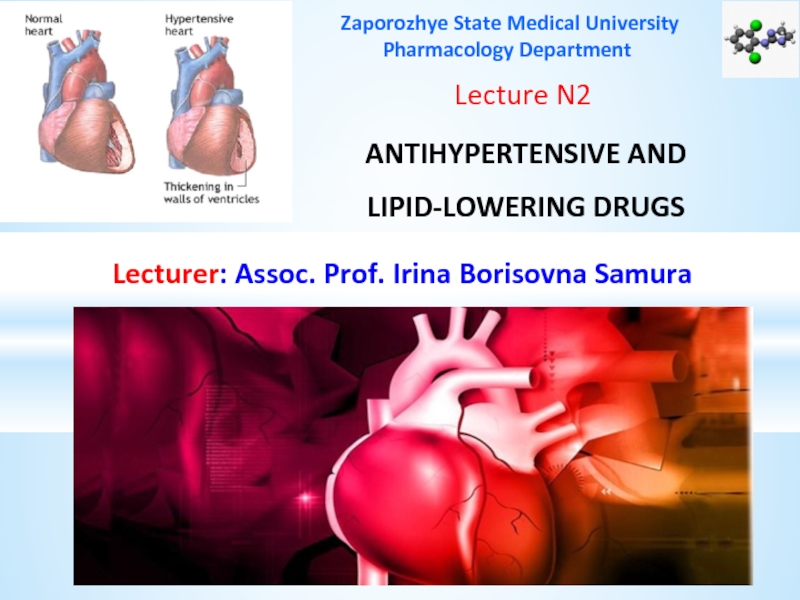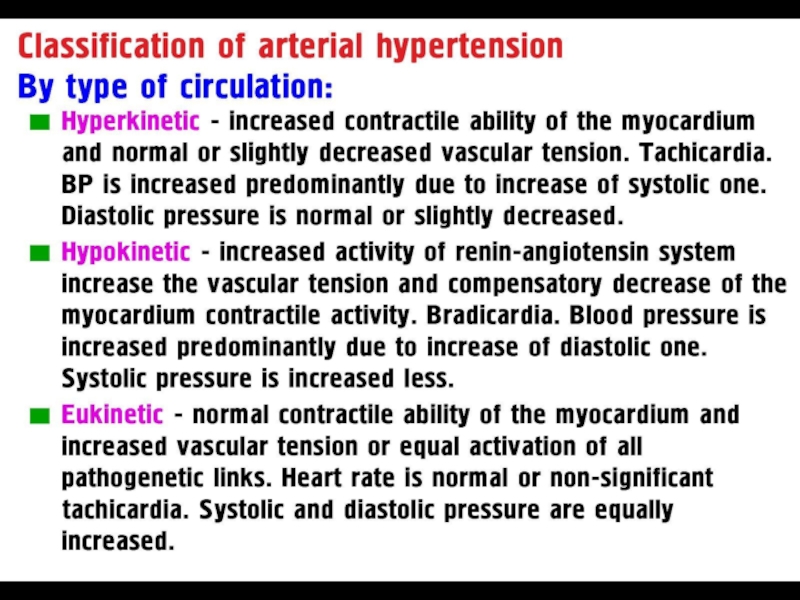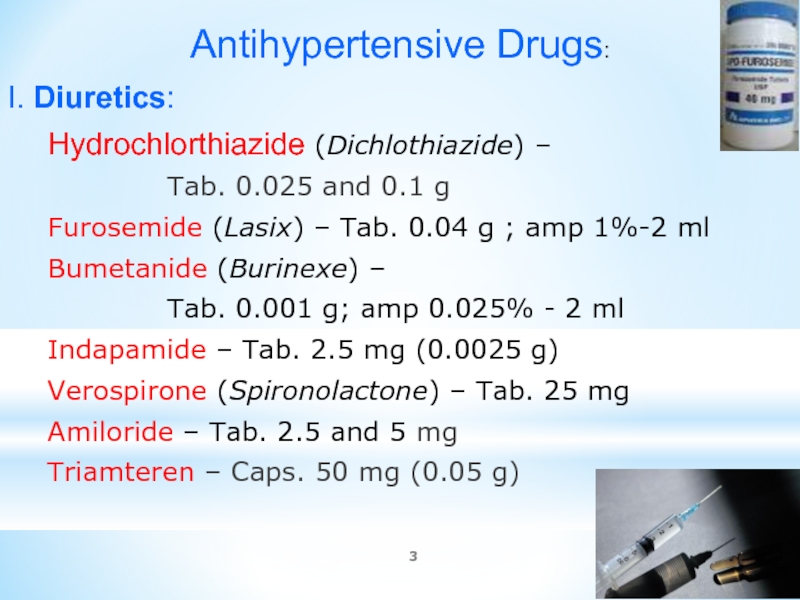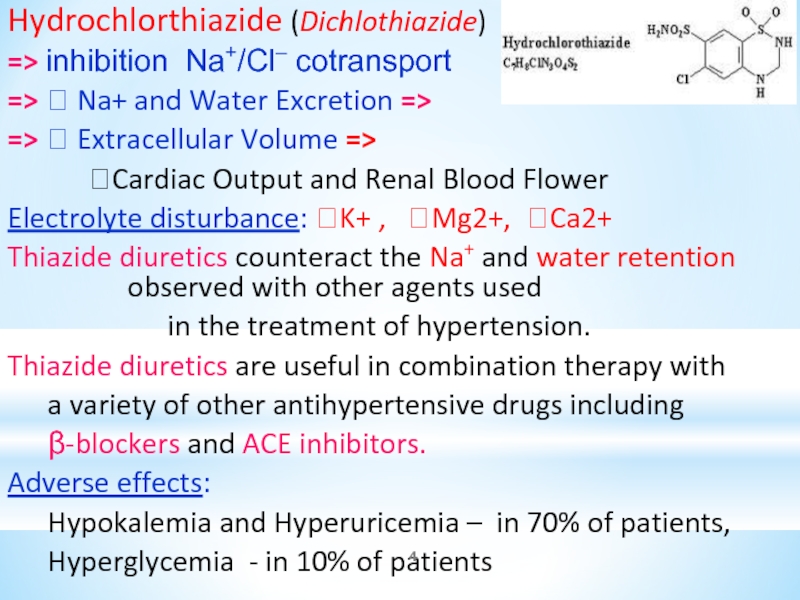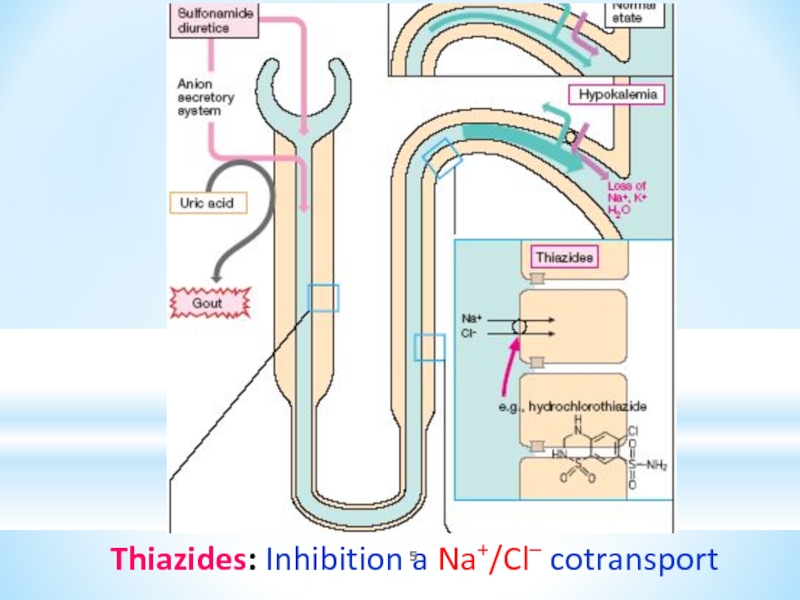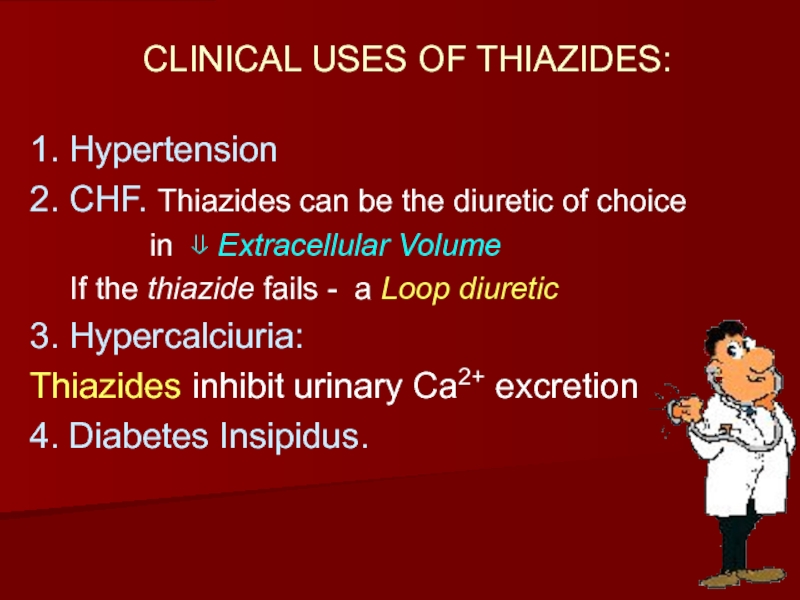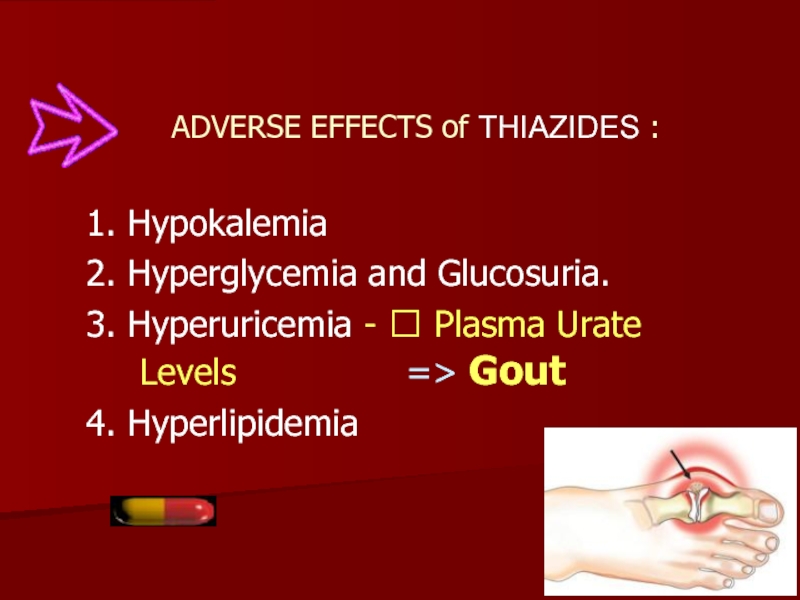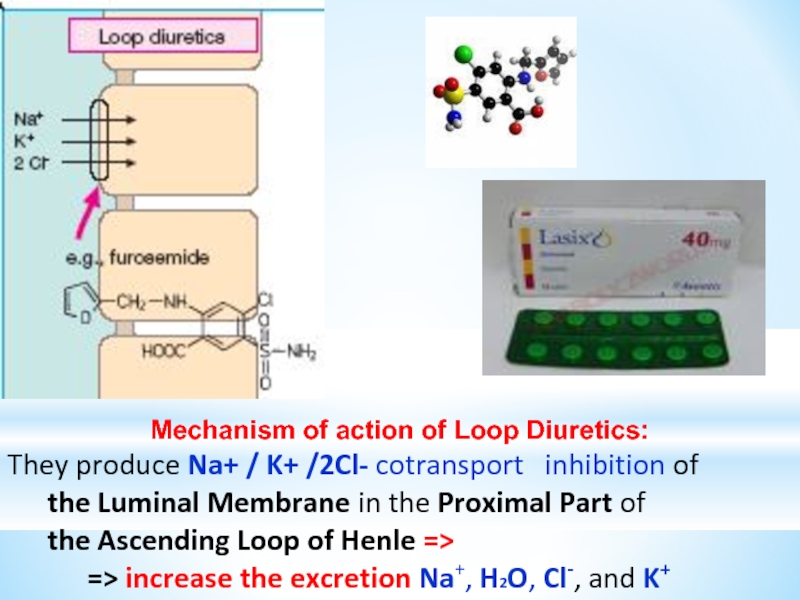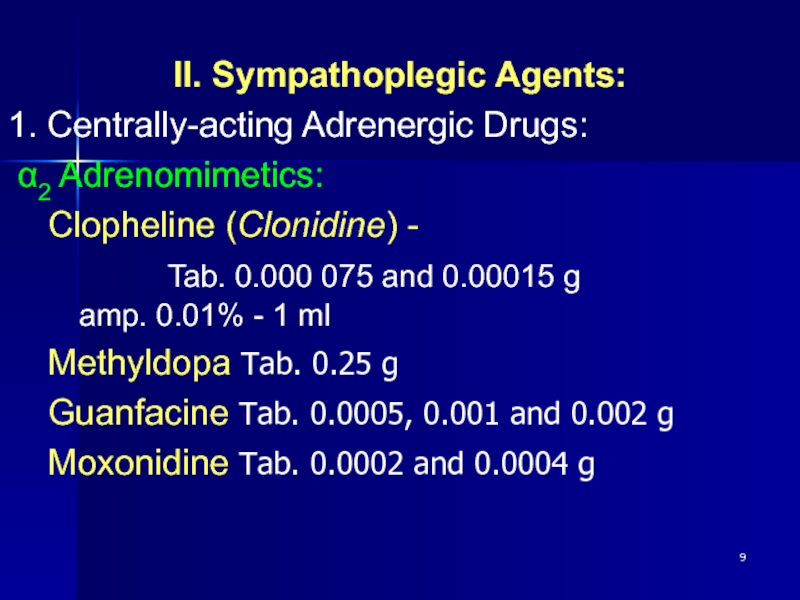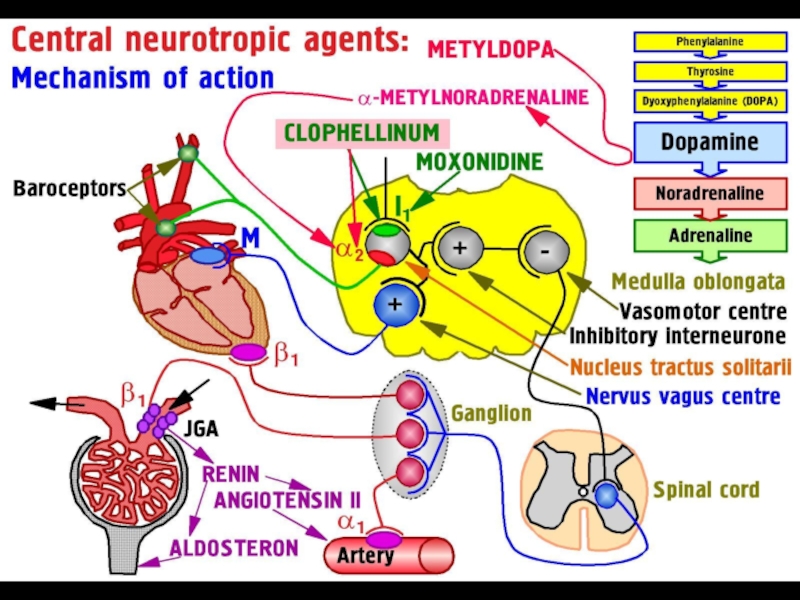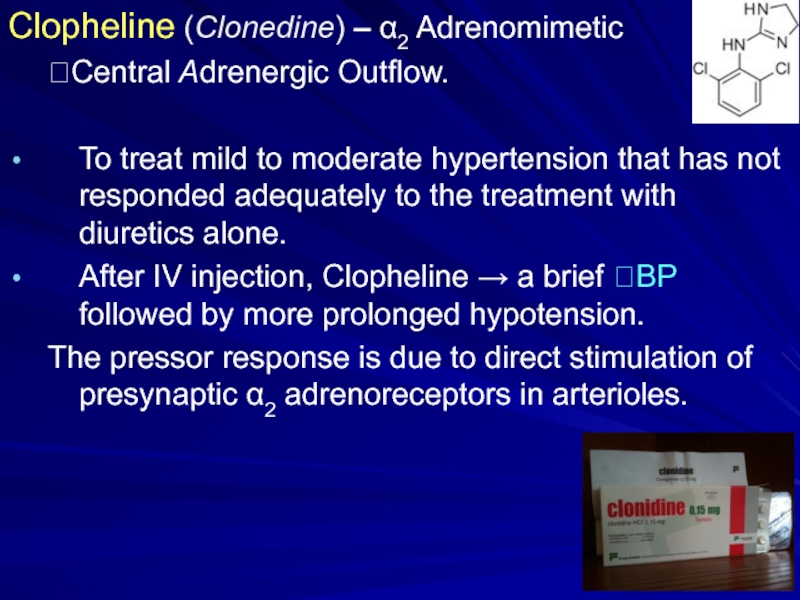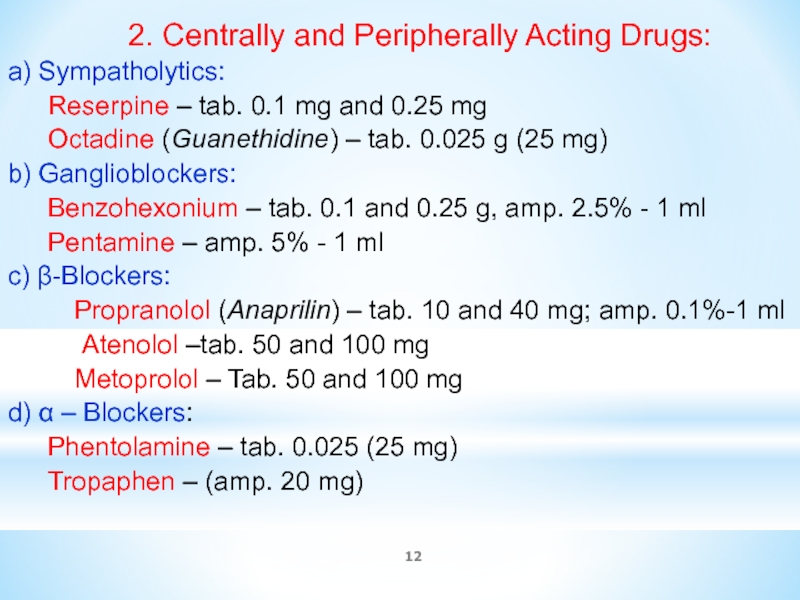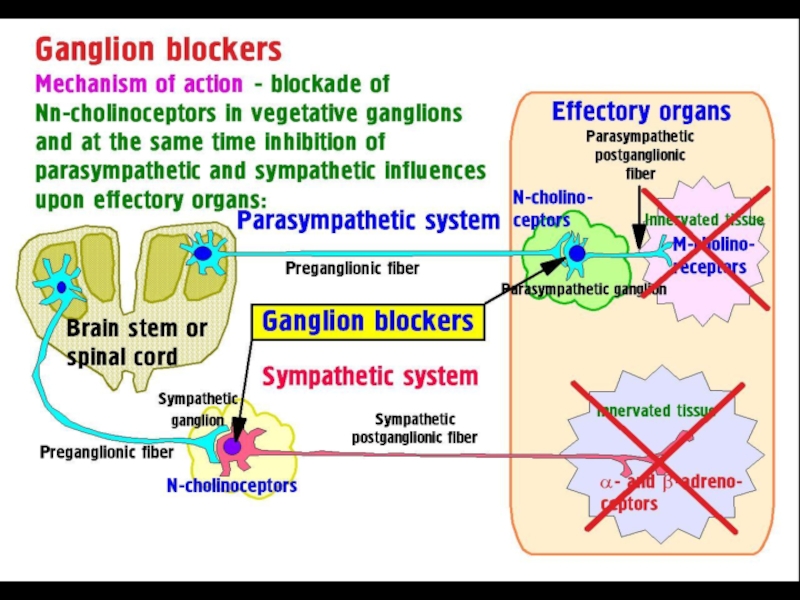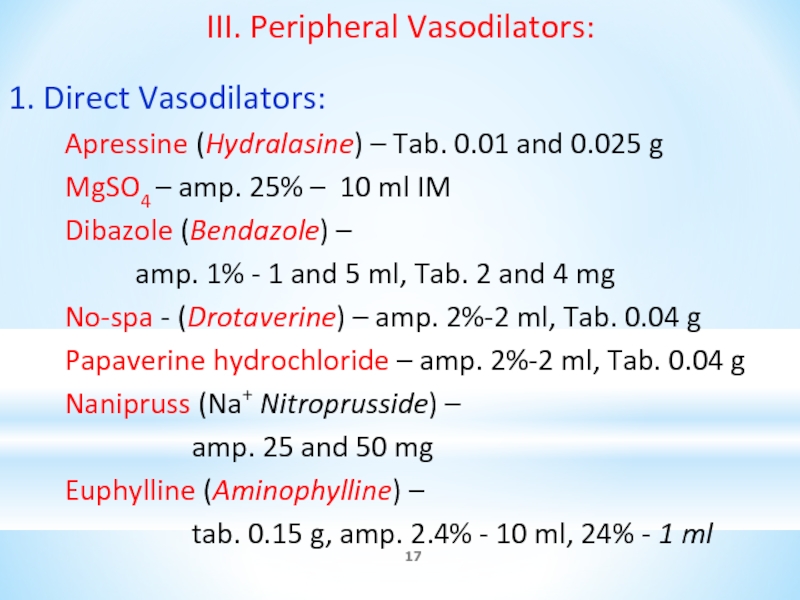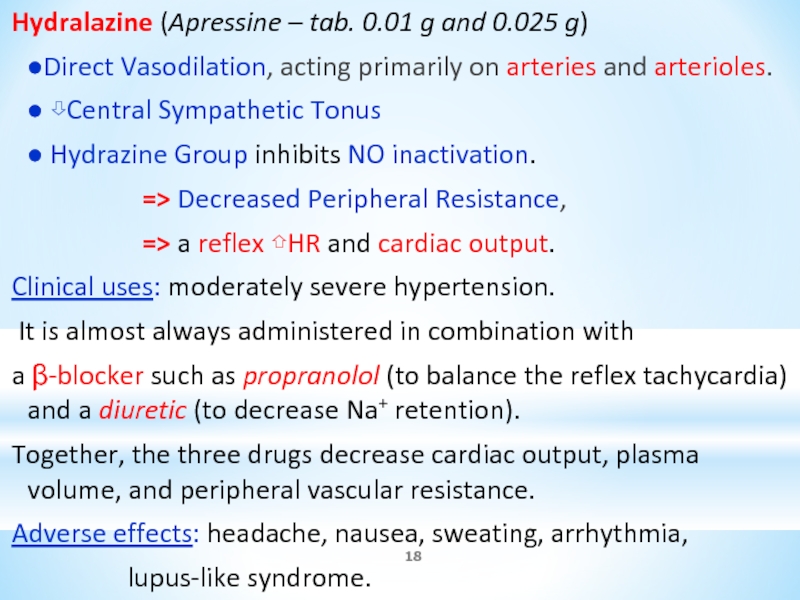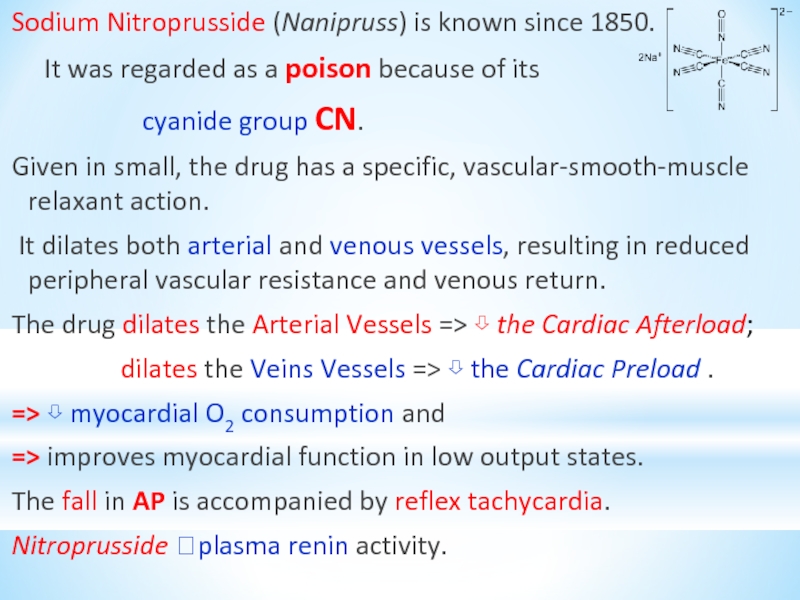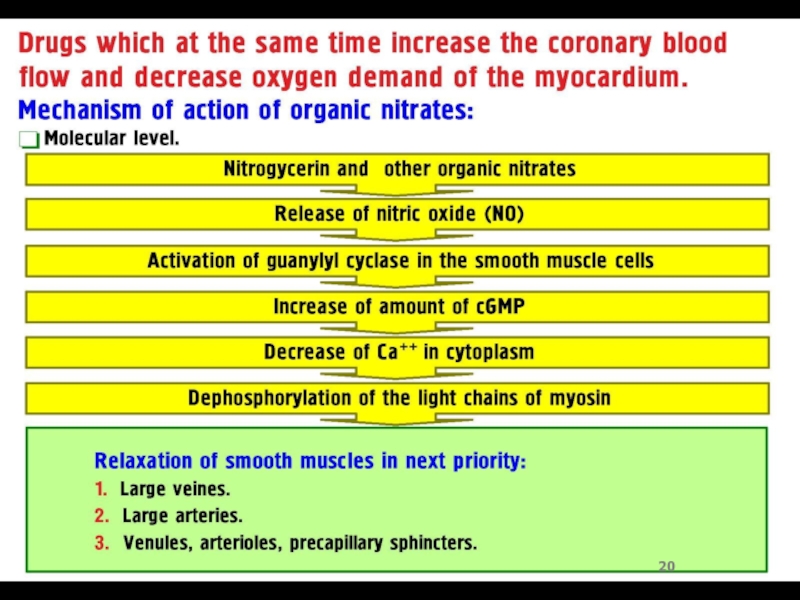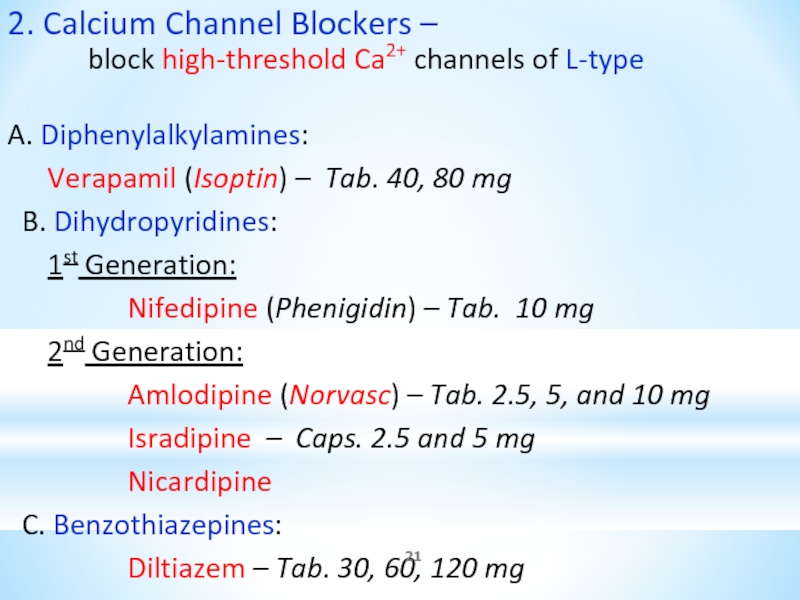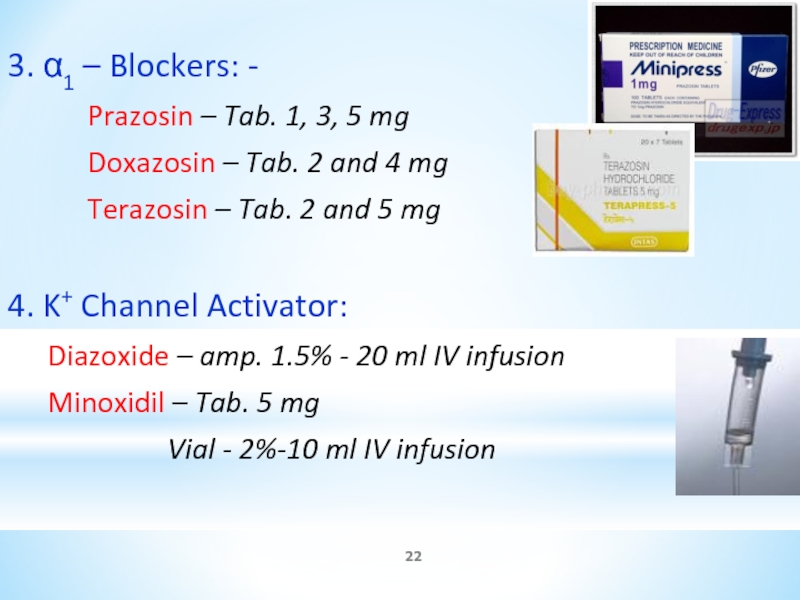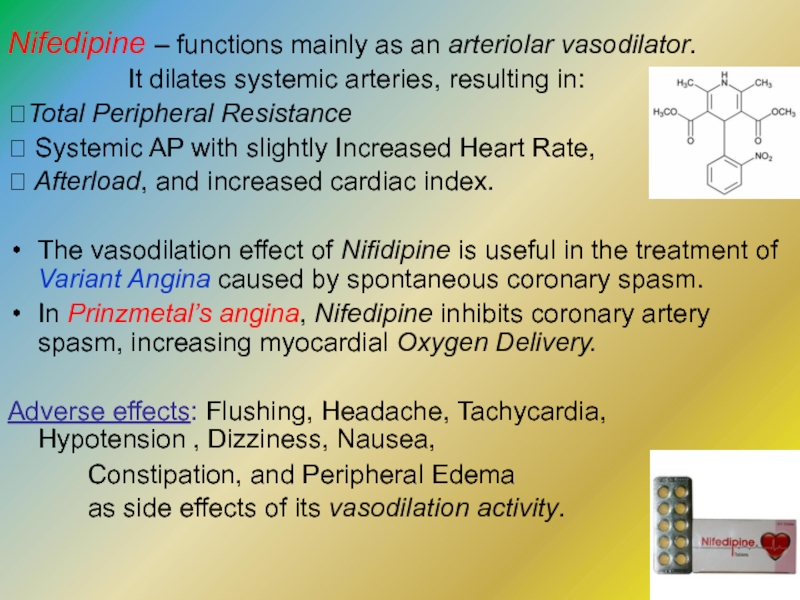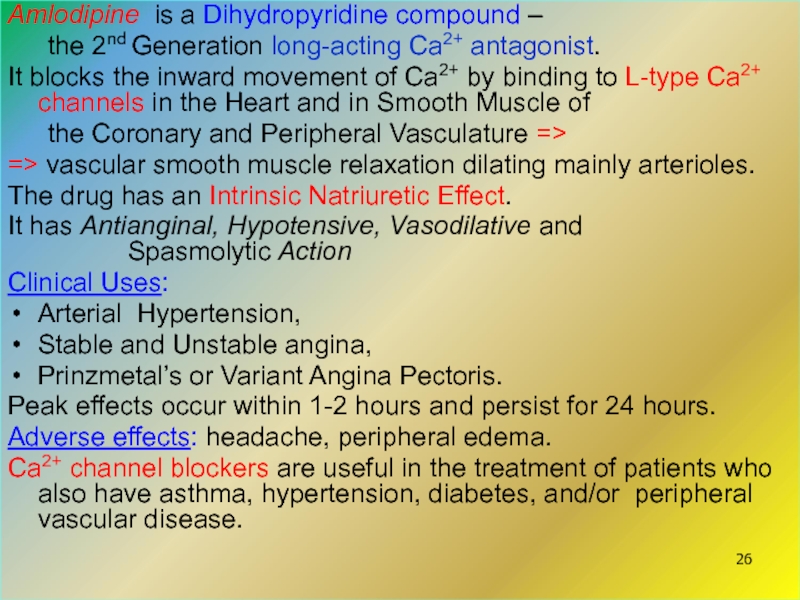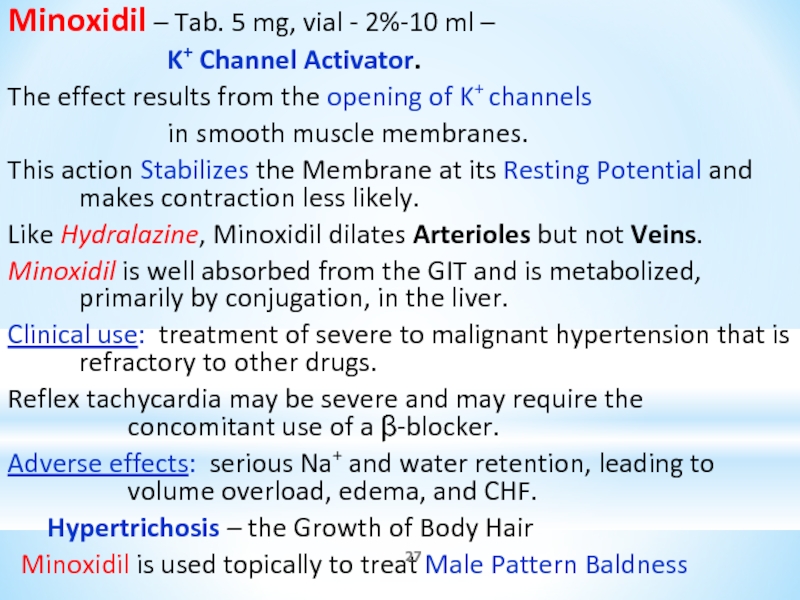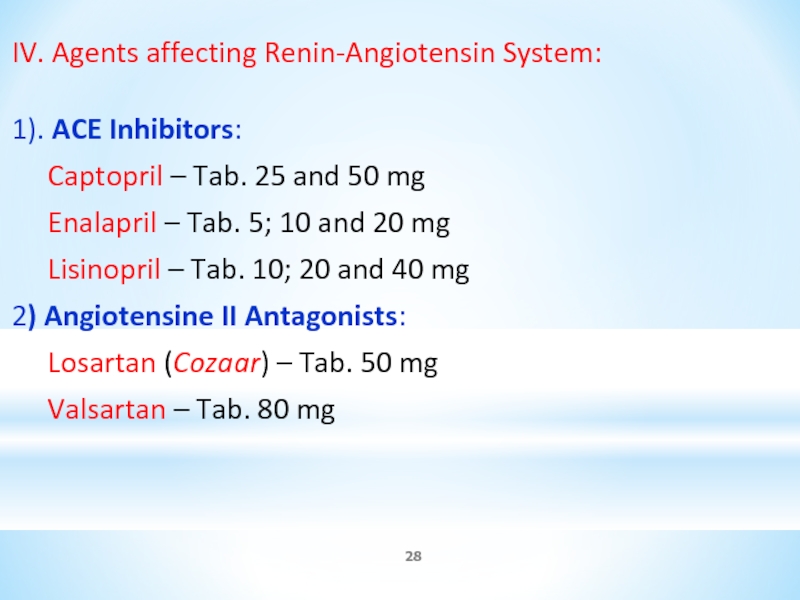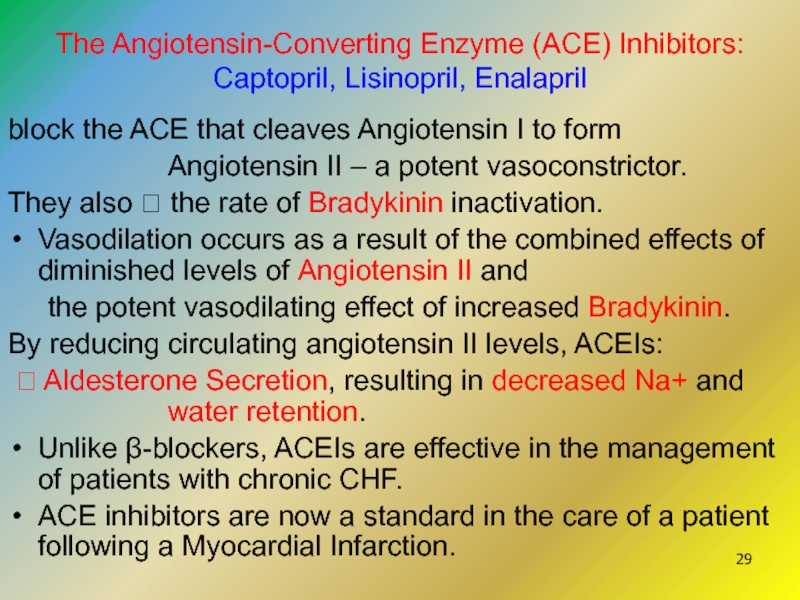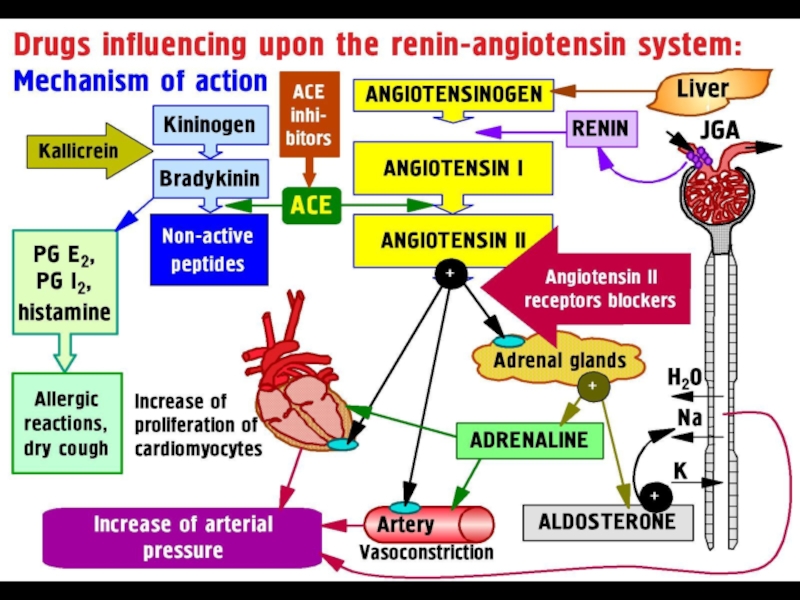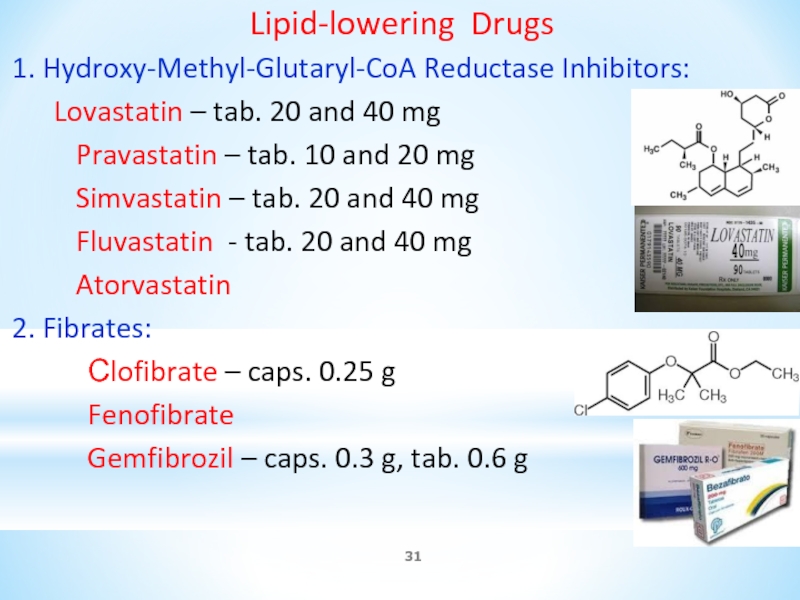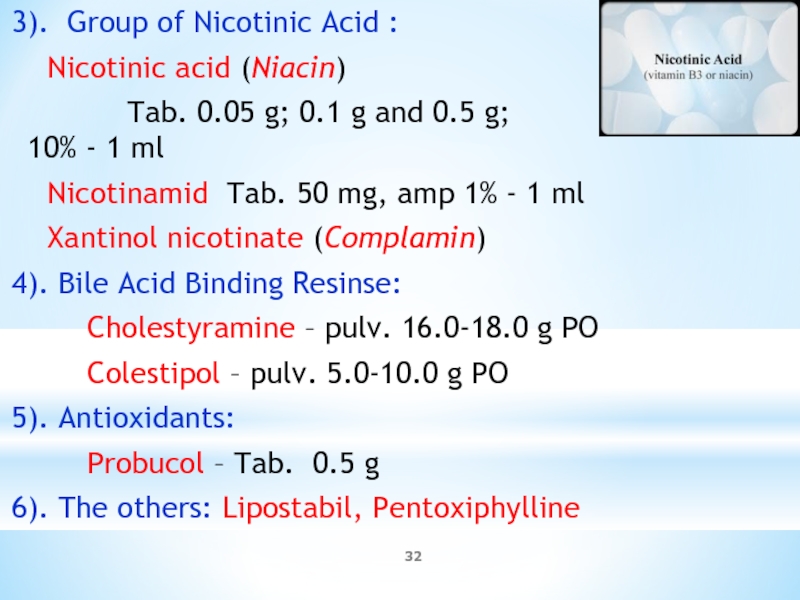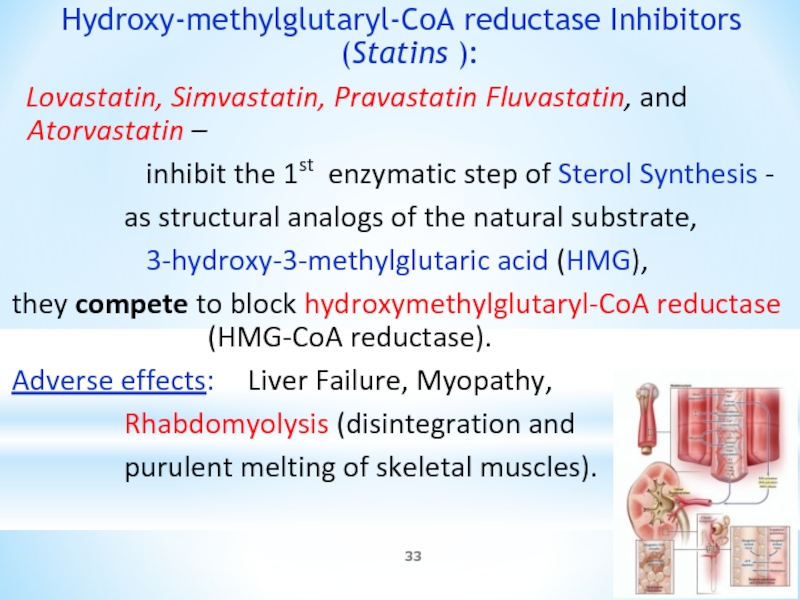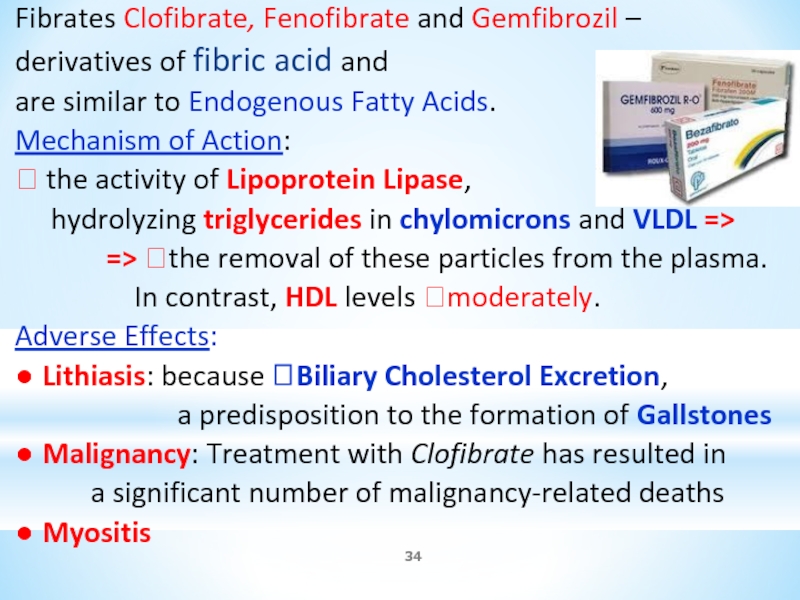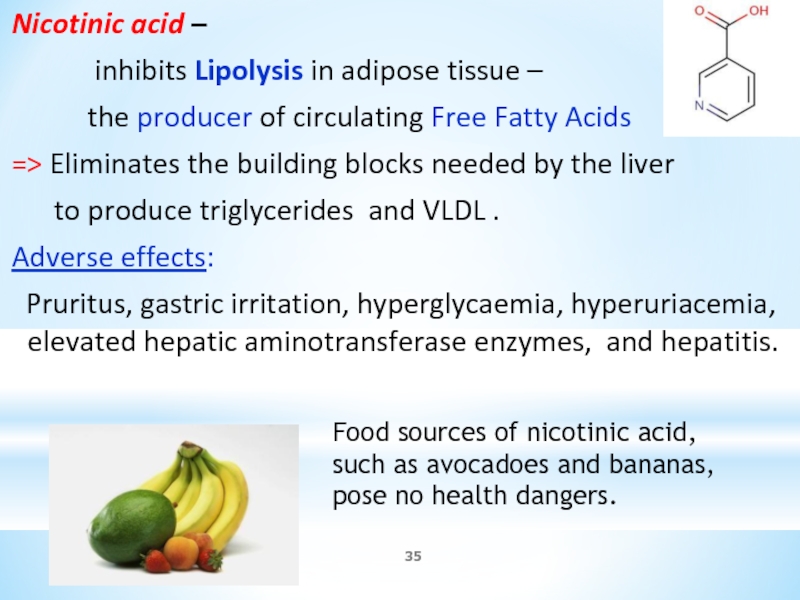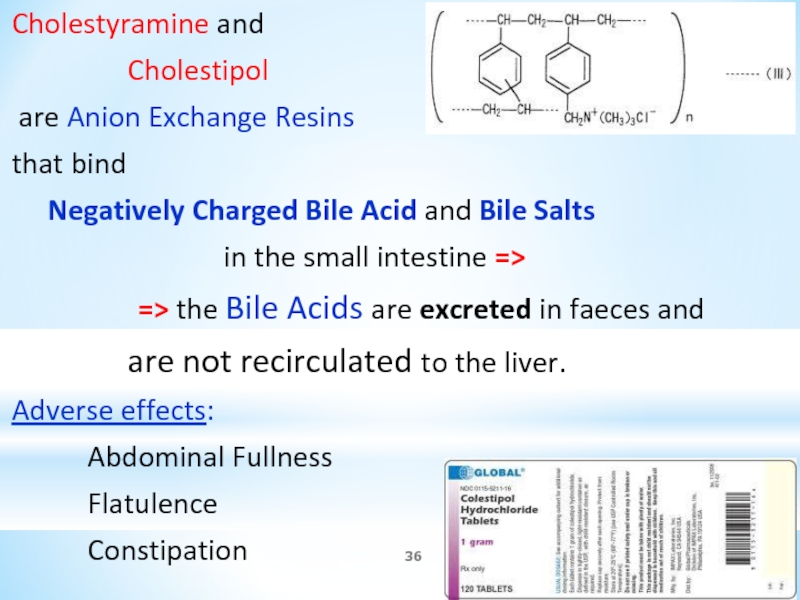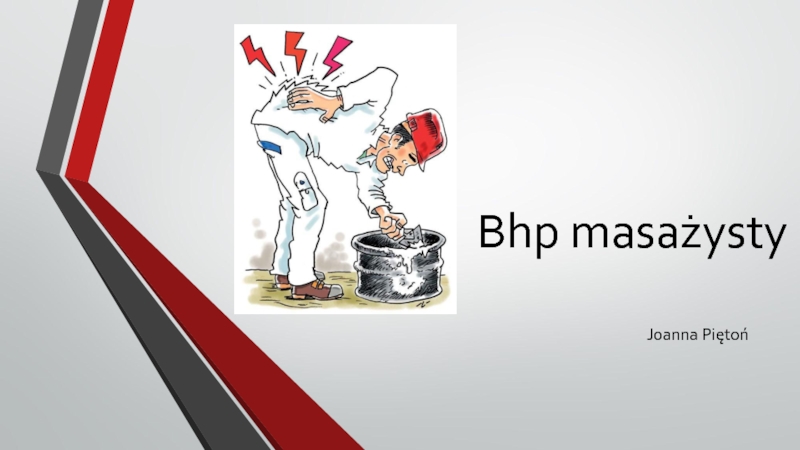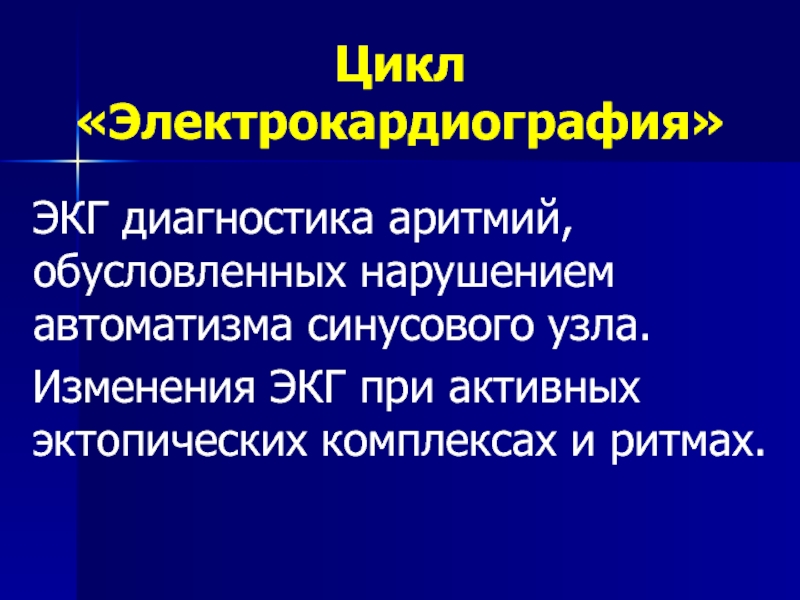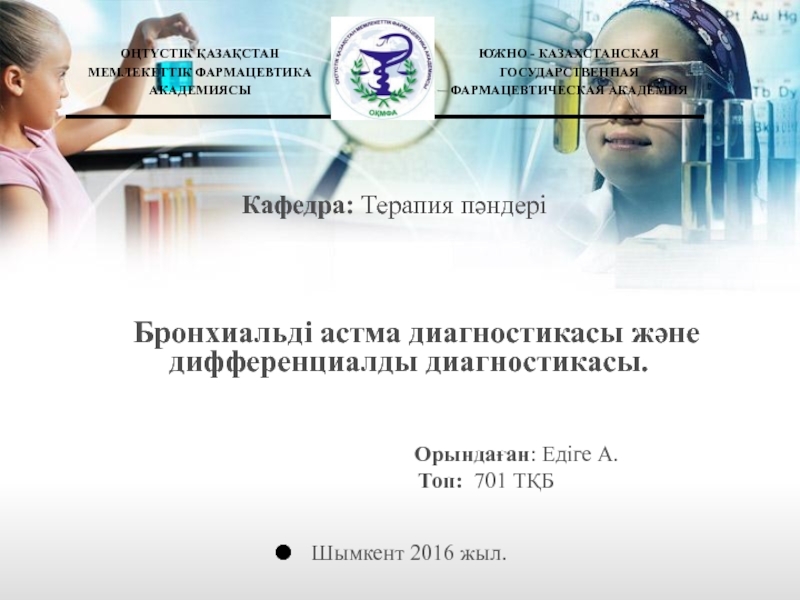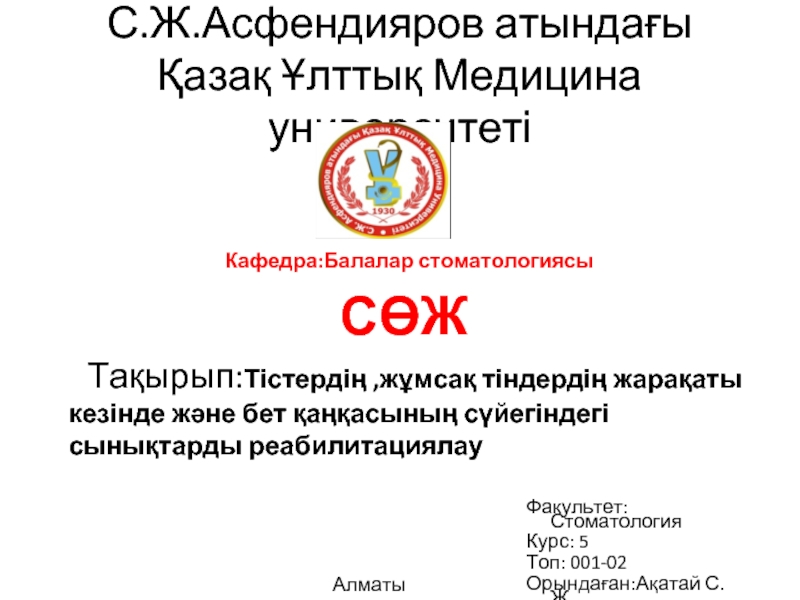Assoc. Prof. Irina Borisovna Samura
- Главная
- Разное
- Дизайн
- Бизнес и предпринимательство
- Аналитика
- Образование
- Развлечения
- Красота и здоровье
- Финансы
- Государство
- Путешествия
- Спорт
- Недвижимость
- Армия
- Графика
- Культурология
- Еда и кулинария
- Лингвистика
- Английский язык
- Астрономия
- Алгебра
- Биология
- География
- Детские презентации
- Информатика
- История
- Литература
- Маркетинг
- Математика
- Медицина
- Менеджмент
- Музыка
- МХК
- Немецкий язык
- ОБЖ
- Обществознание
- Окружающий мир
- Педагогика
- Русский язык
- Технология
- Физика
- Философия
- Химия
- Шаблоны, картинки для презентаций
- Экология
- Экономика
- Юриспруденция
Antihypertensive and lipid-lowering drugs презентация
Содержание
- 1. Antihypertensive and lipid-lowering drugs
- 3. Antihypertensive Drugs: I. Diuretics: Hydrochlorthiazide (Dichlothiazide)
- 4. Hydrochlorthiazide (Dichlothiazide) => inhibition Na+/Cl– cotransport
- 5. Thiazides: Inhibition a Na+/Cl– cotransport
- 6. CLINICAL USES OF THIAZIDES: 1. Hypertension
- 7. ADVERSE EFFECTS of THIAZIDES :
- 8. Mechanism of action of Loop Diuretics: They
- 9. II. Sympathoplegic Agents: 1. Centrally-acting Adrenergic
- 11. Clopheline (Clonedine) – α2 Adrenomimetic ?Central Adrenergic
- 12. 2. Centrally and Peripherally Acting Drugs:
- 13. Reserpine - blocks the Mg 2+/ ATP
- 16. Propranolol - a β-adrenoblocker, is useful for
- 17. III. Peripheral Vasodilators: 1. Direct Vasodilators:
- 18. Hydralazine (Apressine – tab. 0.01 g and
- 19. Sodium Nitroprusside (Nanipruss) is known since 1850.
- 21. 2. Calcium Channel Blockers – block
- 22. 3. α1 – Blockers: -
- 23. Ca2+ Channel Blockers are useful in
- 24. Verapamil appears to
- 25. Nifedipine – functions mainly as an arteriolar
- 26. Amlodipine is a Dihydropyridine compound –
- 27. Minoxidil – Tab. 5 mg, vial -
- 28. IV. Agents affecting Renin-Angiotensin System:
- 29. The Angiotensin-Converting Enzyme (ACE) Inhibitors: Captopril, Lisinopril,
- 31. Lipid-lowering Drugs 1. Hydroxy-Methyl-Glutaryl-CoA Reductase Inhibitors:
- 32. 3). Group of Nicotinic Acid : Nicotinic
- 33. Hydroxy-methylglutaryl-CoA reductase Inhibitors (Statins ): Lovastatin,
- 34. Fibrates Clofibrate, Fenofibrate and Gemfibrozil – derivatives
- 35. Nicotinic acid – inhibits Lipolysis
- 36. Cholestyramine and Cholestipol are
- 37. THANK YOU FOR ATTENTION
Слайд 1ANTIHYPERTENSIVE AND
LIPID-LOWERING DRUGS
Lecture N2
Zaporozhye State Medical University
Pharmacology Department
Lecturer:
Слайд 3Antihypertensive Drugs:
I. Diuretics:
Hydrochlorthiazide (Dichlothiazide) –
Tab. 0.025 and 0.1 g
Furosemide
(Lasix) – Tab. 0.04 g ; amp 1%-2 ml
Bumetanide (Burinexe) –
Tab. 0.001 g; amp 0.025% - 2 ml
Indapamide – Tab. 2.5 mg (0.0025 g)
Verospirone (Spironolactone) – Tab. 25 mg
Amiloride – Tab. 2.5 and 5 mg
Triamteren – Caps. 50 mg (0.05 g)
Bumetanide (Burinexe) –
Tab. 0.001 g; amp 0.025% - 2 ml
Indapamide – Tab. 2.5 mg (0.0025 g)
Verospirone (Spironolactone) – Tab. 25 mg
Amiloride – Tab. 2.5 and 5 mg
Triamteren – Caps. 50 mg (0.05 g)
Слайд 4Hydrochlorthiazide (Dichlothiazide)
=> inhibition Na+/Cl– cotransport
=> ? Na+ and Water Excretion
=>
=> ? Extracellular Volume =>
?Cardiac Output and Renal Blood Flower
Electrolyte disturbance: ?K+ , ?Mg2+, ?Ca2+
Thiazide diuretics counteract the Na+ and water retention observed with other agents used
in the treatment of hypertension.
Thiazide diuretics are useful in combination therapy with
a variety of other antihypertensive drugs including
β-blockers and ACE inhibitors.
Adverse effects:
Hypokalemia and Hyperuricemia – in 70% of patients,
Hyperglycemia - in 10% of patients
=> ? Extracellular Volume =>
?Cardiac Output and Renal Blood Flower
Electrolyte disturbance: ?K+ , ?Mg2+, ?Ca2+
Thiazide diuretics counteract the Na+ and water retention observed with other agents used
in the treatment of hypertension.
Thiazide diuretics are useful in combination therapy with
a variety of other antihypertensive drugs including
β-blockers and ACE inhibitors.
Adverse effects:
Hypokalemia and Hyperuricemia – in 70% of patients,
Hyperglycemia - in 10% of patients
Слайд 6CLINICAL USES OF THIAZIDES:
1. Hypertension
2. CHF. Thiazides can be the diuretic
of choice
in ⇓ Extracellular Volume
If the thiazide fails - a Loop diuretic
3. Hypercalciuria:
Thiazides inhibit urinary Ca2+ excretion
4. Diabetes Insipidus.
in ⇓ Extracellular Volume
If the thiazide fails - a Loop diuretic
3. Hypercalciuria:
Thiazides inhibit urinary Ca2+ excretion
4. Diabetes Insipidus.
Слайд 7
ADVERSE EFFECTS of THIAZIDES :
1. Hypokalemia
2. Hyperglycemia and Glucosuria.
3. Hyperuricemia
- ? Plasma Urate Levels => Gout
4. Hyperlipidemia
4. Hyperlipidemia
Слайд 8Mechanism of action of Loop Diuretics:
They produce Na+ / K+ /2Cl-
cotransport inhibition of
the Luminal Membrane in the Proximal Part of
the Ascending Loop of Henle =>
=> increase the excretion Na+, H2O, Cl-, and K+
the Luminal Membrane in the Proximal Part of
the Ascending Loop of Henle =>
=> increase the excretion Na+, H2O, Cl-, and K+
Слайд 9
II. Sympathoplegic Agents:
1. Centrally-acting Adrenergic Drugs:
α2 Adrenomimetics:
Clopheline (Clonidine)
-
Tab. 0.000 075 and 0.00015 g amp. 0.01% - 1 ml
Methyldopa Tab. 0.25 g
Guanfacine Tab. 0.0005, 0.001 and 0.002 g
Moxonidine Tab. 0.0002 and 0.0004 g
Tab. 0.000 075 and 0.00015 g amp. 0.01% - 1 ml
Methyldopa Tab. 0.25 g
Guanfacine Tab. 0.0005, 0.001 and 0.002 g
Moxonidine Tab. 0.0002 and 0.0004 g
Слайд 11Clopheline (Clonedine) – α2 Adrenomimetic
?Central Adrenergic Outflow.
To treat mild to moderate
hypertension that has not responded adequately to the treatment with diuretics alone.
After IV injection, Clopheline → a brief ?BP followed by more prolonged hypotension.
The pressor response is due to direct stimulation of presynaptic α2 adrenoreceptors in arterioles.
After IV injection, Clopheline → a brief ?BP followed by more prolonged hypotension.
The pressor response is due to direct stimulation of presynaptic α2 adrenoreceptors in arterioles.
Слайд 12
2. Centrally and Peripherally Acting Drugs:
a) Sympatholytics:
Reserpine – tab. 0.1
mg and 0.25 mg
Octadine (Guanethidine) – tab. 0.025 g (25 mg)
b) Ganglioblockers:
Benzohexonium – tab. 0.1 and 0.25 g, amp. 2.5% - 1 ml
Pentamine – amp. 5% - 1 ml
c) β-Blockers:
Propranolol (Anaprilin) – tab. 10 and 40 mg; amp. 0.1%-1 ml
Atenolol –tab. 50 and 100 mg
Metoprolol – Tab. 50 and 100 mg
d) α – Blockers:
Phentolamine – tab. 0.025 (25 mg)
Tropaphen – (amp. 20 mg)
Octadine (Guanethidine) – tab. 0.025 g (25 mg)
b) Ganglioblockers:
Benzohexonium – tab. 0.1 and 0.25 g, amp. 2.5% - 1 ml
Pentamine – amp. 5% - 1 ml
c) β-Blockers:
Propranolol (Anaprilin) – tab. 10 and 40 mg; amp. 0.1%-1 ml
Atenolol –tab. 50 and 100 mg
Metoprolol – Tab. 50 and 100 mg
d) α – Blockers:
Phentolamine – tab. 0.025 (25 mg)
Tropaphen – (amp. 20 mg)
Слайд 13Reserpine - blocks the Mg 2+/ ATP – dependent transport of
amines - Noradrenaline , Dopamine and Serotonin
from the cytoplasm into storage vesicles
in the adrenergic nerves of all body tissues
=> depletion of Noradrenaline levels in the adrenergic neuron,
since MAO degrades the Noradrenaline (NA)
=> Sympathetic function is impaired because of ?NA release
Reserpine ? Blood Pressure by a combination of :
? Cardiac Output and
? Peripheral Vascular Resistance
Adverse effect:
Sedation, Lassitude, Nightmares, Mental Depression,
Extrapyramidal Effects resembling Parkinson's disease
as a result of dopamine depletion in the corpus striatum
GIT abnormalities - diarrhea, gastrointestinal cramps,
increase of gastric acid secretion, ulcer
from the cytoplasm into storage vesicles
in the adrenergic nerves of all body tissues
=> depletion of Noradrenaline levels in the adrenergic neuron,
since MAO degrades the Noradrenaline (NA)
=> Sympathetic function is impaired because of ?NA release
Reserpine ? Blood Pressure by a combination of :
? Cardiac Output and
? Peripheral Vascular Resistance
Adverse effect:
Sedation, Lassitude, Nightmares, Mental Depression,
Extrapyramidal Effects resembling Parkinson's disease
as a result of dopamine depletion in the corpus striatum
GIT abnormalities - diarrhea, gastrointestinal cramps,
increase of gastric acid secretion, ulcer
Слайд 16Propranolol - a β-adrenoblocker, is useful for ?BP in mild
to moderate hypertension
In Severe Hypertension, it is especially useful in preventing the reflex tachycardia that results from treatment with direct vasodilators
Propranolol ?BP by:
? Cardiac Output
? Sympathetic outflow from the CNS
? Renin Release and Renin-Angiotensin-Aldosteron system
Adverse effect: Bradycardia, Bronchospasm, CHF, Vasoconstriction, Cold Extremities,
Intermittent Claudication, Fatigue, Lethargy,
Mental Depression, Memory Loss, Hallucination, Impotence,
Dislipidemia: ↑ Cholesterol, ↑ Triglycerides ,
?HDL-cholesterol
In Severe Hypertension, it is especially useful in preventing the reflex tachycardia that results from treatment with direct vasodilators
Propranolol ?BP by:
? Cardiac Output
? Sympathetic outflow from the CNS
? Renin Release and Renin-Angiotensin-Aldosteron system
Adverse effect: Bradycardia, Bronchospasm, CHF, Vasoconstriction, Cold Extremities,
Intermittent Claudication, Fatigue, Lethargy,
Mental Depression, Memory Loss, Hallucination, Impotence,
Dislipidemia: ↑ Cholesterol, ↑ Triglycerides ,
?HDL-cholesterol
Слайд 17III. Peripheral Vasodilators:
1. Direct Vasodilators:
Apressine
(Hydralasine) – Tab. 0.01 and 0.025 g
MgSO4 – amp. 25% – 10 ml IM
Dibazole (Bendazole) –
amp. 1% - 1 and 5 ml, Tab. 2 and 4 mg
No-spa - (Drotaverine) – amp. 2%-2 ml, Tab. 0.04 g
Papaverine hydrochloride – amp. 2%-2 ml, Tab. 0.04 g
Nanipruss (Na+ Nitroprusside) –
amp. 25 and 50 mg
Euphylline (Aminophylline) –
tab. 0.15 g, amp. 2.4% - 10 ml, 24% - 1 ml
MgSO4 – amp. 25% – 10 ml IM
Dibazole (Bendazole) –
amp. 1% - 1 and 5 ml, Tab. 2 and 4 mg
No-spa - (Drotaverine) – amp. 2%-2 ml, Tab. 0.04 g
Papaverine hydrochloride – amp. 2%-2 ml, Tab. 0.04 g
Nanipruss (Na+ Nitroprusside) –
amp. 25 and 50 mg
Euphylline (Aminophylline) –
tab. 0.15 g, amp. 2.4% - 10 ml, 24% - 1 ml
Слайд 18Hydralazine (Apressine – tab. 0.01 g and 0.025 g)
●Direct Vasodilation,
acting primarily on arteries and arterioles.
● ⇩Central Sympathetic Tonus
● Hydrazine Group inhibits NO inactivation.
=> Decreased Peripheral Resistance,
=> a reflex ⇧HR and cardiac output.
Clinical uses: moderately severe hypertension.
It is almost always administered in combination with
a β-blocker such as propranolol (to balance the reflex tachycardia) and a diuretic (to decrease Na+ retention).
Together, the three drugs decrease cardiac output, plasma volume, and peripheral vascular resistance.
Adverse effects: headache, nausea, sweating, arrhythmia,
lupus-like syndrome.
● ⇩Central Sympathetic Tonus
● Hydrazine Group inhibits NO inactivation.
=> Decreased Peripheral Resistance,
=> a reflex ⇧HR and cardiac output.
Clinical uses: moderately severe hypertension.
It is almost always administered in combination with
a β-blocker such as propranolol (to balance the reflex tachycardia) and a diuretic (to decrease Na+ retention).
Together, the three drugs decrease cardiac output, plasma volume, and peripheral vascular resistance.
Adverse effects: headache, nausea, sweating, arrhythmia,
lupus-like syndrome.
Слайд 19Sodium Nitroprusside (Nanipruss) is known since 1850.
It
was regarded as a poison because of its
cyanide group CN.
Given in small, the drug has a specific, vascular-smooth-muscle relaxant action.
It dilates both arterial and venous vessels, resulting in reduced peripheral vascular resistance and venous return.
The drug dilates the Arterial Vessels => ⇩ the Cardiac Afterload;
dilates the Veins Vessels => ⇩ the Cardiac Preload .
=> ⇩ myocardial O2 consumption and
=> improves myocardial function in low output states.
The fall in AP is accompanied by reflex tachycardia.
Nitroprusside ?plasma renin activity.
cyanide group CN.
Given in small, the drug has a specific, vascular-smooth-muscle relaxant action.
It dilates both arterial and venous vessels, resulting in reduced peripheral vascular resistance and venous return.
The drug dilates the Arterial Vessels => ⇩ the Cardiac Afterload;
dilates the Veins Vessels => ⇩ the Cardiac Preload .
=> ⇩ myocardial O2 consumption and
=> improves myocardial function in low output states.
The fall in AP is accompanied by reflex tachycardia.
Nitroprusside ?plasma renin activity.
Слайд 212. Calcium Channel Blockers – block high-threshold Ca2+ channels of L-type
A. Diphenylalkylamines:
Verapamil (Isoptin) – Tab. 40, 80 mg
B. Dihydropyridines:
1st Generation:
Nifedipine (Phenigidin) – Tab. 10 mg
2nd Generation:
Amlodipine (Norvasc) – Tab. 2.5, 5, and 10 mg
Isradipine – Caps. 2.5 and 5 mg
Nicardipine
C. Benzothiazepines:
Diltiazem – Tab. 30, 60, 120 mg
Слайд 22
3. α1 – Blockers: -
Prazosin – Tab. 1, 3, 5
mg
Doxazosin – Tab. 2 and 4 mg
Terazosin – Tab. 2 and 5 mg
4. K+ Channel Activator:
Diazoxide – amp. 1.5% - 20 ml IV infusion
Minoxidil – Tab. 5 mg
Vial - 2%-10 ml IV infusion
Doxazosin – Tab. 2 and 4 mg
Terazosin – Tab. 2 and 5 mg
4. K+ Channel Activator:
Diazoxide – amp. 1.5% - 20 ml IV infusion
Minoxidil – Tab. 5 mg
Vial - 2%-10 ml IV infusion
Слайд 23 Ca2+ Channel Blockers are useful in the Treatment of
Patients with:
▼ Asthma
▼ Diabetes
▼ Peripheral Vascular Diseases
▼ Asthma
▼ Diabetes
▼ Peripheral Vascular Diseases
Слайд 24
Verapamil appears to have antianginal, antihypertensive and antiarrhythmic
action.
It manages unstable and chronic stable angina by:
? Afterload => ? O2 Consumption.
It also ? myocardial O2 demand and cardiac work by:
Exerting Negative Inotropic Effect - ? Heart Rate:
the drug slows Cardiac Conduction directly .
In patients with Prinzmetal’s Variant Angina:
Relieving coronary artery spasm => myocardial ?O2 Delivery
Adverse Effects:
Myocardial Depression, including Cardiac Arrest,
Bradycardia, AV block, Hypotension, Heart Failure, Constipation, Peripheral Edema.
It manages unstable and chronic stable angina by:
? Afterload => ? O2 Consumption.
It also ? myocardial O2 demand and cardiac work by:
Exerting Negative Inotropic Effect - ? Heart Rate:
the drug slows Cardiac Conduction directly .
In patients with Prinzmetal’s Variant Angina:
Relieving coronary artery spasm => myocardial ?O2 Delivery
Adverse Effects:
Myocardial Depression, including Cardiac Arrest,
Bradycardia, AV block, Hypotension, Heart Failure, Constipation, Peripheral Edema.
Слайд 25Nifedipine – functions mainly as an arteriolar vasodilator.
It dilates systemic
arteries, resulting in:
?Total Peripheral Resistance
? Systemic AP with slightly Increased Heart Rate,
? Afterload, and increased cardiac index.
The vasodilation effect of Nifidipine is useful in the treatment of Variant Angina caused by spontaneous coronary spasm.
In Prinzmetal’s angina, Nifedipine inhibits coronary artery spasm, increasing myocardial Oxygen Delivery.
Adverse effects: Flushing, Headache, Tachycardia, Hypotension , Dizziness, Nausea,
Constipation, and Peripheral Edema
as side effects of its vasodilation activity.
?Total Peripheral Resistance
? Systemic AP with slightly Increased Heart Rate,
? Afterload, and increased cardiac index.
The vasodilation effect of Nifidipine is useful in the treatment of Variant Angina caused by spontaneous coronary spasm.
In Prinzmetal’s angina, Nifedipine inhibits coronary artery spasm, increasing myocardial Oxygen Delivery.
Adverse effects: Flushing, Headache, Tachycardia, Hypotension , Dizziness, Nausea,
Constipation, and Peripheral Edema
as side effects of its vasodilation activity.
Слайд 26Amlodipine is a Dihydropyridine compound –
the 2nd Generation long-acting Ca2+
antagonist.
It blocks the inward movement of Ca2+ by binding to L-type Ca2+ channels in the Heart and in Smooth Muscle of
the Coronary and Peripheral Vasculature =>
=> vascular smooth muscle relaxation dilating mainly arterioles.
The drug has an Intrinsic Natriuretic Effect.
It has Antianginal, Hypotensive, Vasodilative and Spasmolytic Action
Clinical Uses:
Arterial Hypertension,
Stable and Unstable angina,
Prinzmetal’s or Variant Angina Pectoris.
Peak effects occur within 1-2 hours and persist for 24 hours.
Adverse effects: headache, peripheral edema.
Ca2+ channel blockers are useful in the treatment of patients who also have asthma, hypertension, diabetes, and/or peripheral vascular disease.
It blocks the inward movement of Ca2+ by binding to L-type Ca2+ channels in the Heart and in Smooth Muscle of
the Coronary and Peripheral Vasculature =>
=> vascular smooth muscle relaxation dilating mainly arterioles.
The drug has an Intrinsic Natriuretic Effect.
It has Antianginal, Hypotensive, Vasodilative and Spasmolytic Action
Clinical Uses:
Arterial Hypertension,
Stable and Unstable angina,
Prinzmetal’s or Variant Angina Pectoris.
Peak effects occur within 1-2 hours and persist for 24 hours.
Adverse effects: headache, peripheral edema.
Ca2+ channel blockers are useful in the treatment of patients who also have asthma, hypertension, diabetes, and/or peripheral vascular disease.
Слайд 27Minoxidil – Tab. 5 mg, vial - 2%-10 ml –
K+
Channel Activator.
The effect results from the opening of K+ channels
in smooth muscle membranes.
This action Stabilizes the Membrane at its Resting Potential and makes contraction less likely.
Like Hydralazine, Minoxidil dilates Arterioles but not Veins.
Minoxidil is well absorbed from the GIT and is metabolized, primarily by conjugation, in the liver.
Clinical use: treatment of severe to malignant hypertension that is refractory to other drugs.
Reflex tachycardia may be severe and may require the concomitant use of a β-blocker.
Adverse effects: serious Na+ and water retention, leading to volume overload, edema, and CHF.
Hypertrichosis – the Growth of Body Hair
Minoxidil is used topically to treat Male Pattern Baldness
The effect results from the opening of K+ channels
in smooth muscle membranes.
This action Stabilizes the Membrane at its Resting Potential and makes contraction less likely.
Like Hydralazine, Minoxidil dilates Arterioles but not Veins.
Minoxidil is well absorbed from the GIT and is metabolized, primarily by conjugation, in the liver.
Clinical use: treatment of severe to malignant hypertension that is refractory to other drugs.
Reflex tachycardia may be severe and may require the concomitant use of a β-blocker.
Adverse effects: serious Na+ and water retention, leading to volume overload, edema, and CHF.
Hypertrichosis – the Growth of Body Hair
Minoxidil is used topically to treat Male Pattern Baldness
Слайд 28IV. Agents affecting Renin-Angiotensin System:
1). ACE Inhibitors:
Captopril – Tab. 25
and 50 mg
Enalapril – Tab. 5; 10 and 20 mg
Lisinopril – Tab. 10; 20 and 40 mg
2) Angiotensine II Antagonists:
Losartan (Cozaar) – Tab. 50 mg
Valsartan – Tab. 80 mg
Enalapril – Tab. 5; 10 and 20 mg
Lisinopril – Tab. 10; 20 and 40 mg
2) Angiotensine II Antagonists:
Losartan (Cozaar) – Tab. 50 mg
Valsartan – Tab. 80 mg
Слайд 29The Angiotensin-Converting Enzyme (ACE) Inhibitors:
Captopril, Lisinopril, Enalapril
block the ACE that
cleaves Angiotensin I to form
Angiotensin II – a potent vasoconstrictor.
They also ? the rate of Bradykinin inactivation.
Vasodilation occurs as a result of the combined effects of diminished levels of Angiotensin II and
the potent vasodilating effect of increased Bradykinin.
By reducing circulating angiotensin II levels, ACEIs:
? Aldesterone Secretion, resulting in decreased Na+ and water retention.
Unlike β-blockers, ACEIs are effective in the management of patients with chronic CHF.
ACE inhibitors are now a standard in the care of a patient following a Myocardial Infarction.
Angiotensin II – a potent vasoconstrictor.
They also ? the rate of Bradykinin inactivation.
Vasodilation occurs as a result of the combined effects of diminished levels of Angiotensin II and
the potent vasodilating effect of increased Bradykinin.
By reducing circulating angiotensin II levels, ACEIs:
? Aldesterone Secretion, resulting in decreased Na+ and water retention.
Unlike β-blockers, ACEIs are effective in the management of patients with chronic CHF.
ACE inhibitors are now a standard in the care of a patient following a Myocardial Infarction.
Слайд 31Lipid-lowering Drugs
1. Hydroxy-Methyl-Glutaryl-CoA Reductase Inhibitors:
Lovastatin – tab. 20
and 40 mg
Pravastatin – tab. 10 and 20 mg
Simvastatin – tab. 20 and 40 mg
Fluvastatin - tab. 20 and 40 mg
Atorvastatin
2. Fibrates:
Сlofibrate – caps. 0.25 g
Fenofibrate
Gemfibrozil – caps. 0.3 g, tab. 0.6 g
Pravastatin – tab. 10 and 20 mg
Simvastatin – tab. 20 and 40 mg
Fluvastatin - tab. 20 and 40 mg
Atorvastatin
2. Fibrates:
Сlofibrate – caps. 0.25 g
Fenofibrate
Gemfibrozil – caps. 0.3 g, tab. 0.6 g
Слайд 323). Group of Nicotinic Acid :
Nicotinic acid (Niacin)
Tab. 0.05 g;
0.1 g and 0.5 g; amp. 10% - 1 ml
Nicotinamid Tab. 50 mg, amp 1% - 1 ml
Xantinol nicotinate (Complamin)
4). Bile Acid Binding Resinse:
Cholestyramine – pulv. 16.0-18.0 g PO
Colestipol – pulv. 5.0-10.0 g PO
5). Antioxidants:
Probucol – Tab. 0.5 g
6). The others: Lipostabil, Pentoxiphylline
Nicotinamid Tab. 50 mg, amp 1% - 1 ml
Xantinol nicotinate (Complamin)
4). Bile Acid Binding Resinse:
Cholestyramine – pulv. 16.0-18.0 g PO
Colestipol – pulv. 5.0-10.0 g PO
5). Antioxidants:
Probucol – Tab. 0.5 g
6). The others: Lipostabil, Pentoxiphylline
Слайд 33Hydroxy-methylglutaryl-CoA reductase Inhibitors (Statins ):
Lovastatin, Simvastatin, Pravastatin Fluvastatin, and Atorvastatin
–
inhibit the 1st enzymatic step of Sterol Synthesis -
as structural analogs of the natural substrate,
3-hydroxy-3-methylglutaric acid (HMG),
they compete to block hydroxymethylglutaryl-CoA reductase (HMG-CoA reductase).
Adverse effects: Liver Failure, Myopathy,
Rhabdomyolysis (disintegration and
purulent melting of skeletal muscles).
inhibit the 1st enzymatic step of Sterol Synthesis -
as structural analogs of the natural substrate,
3-hydroxy-3-methylglutaric acid (HMG),
they compete to block hydroxymethylglutaryl-CoA reductase (HMG-CoA reductase).
Adverse effects: Liver Failure, Myopathy,
Rhabdomyolysis (disintegration and
purulent melting of skeletal muscles).
Слайд 34Fibrates Clofibrate, Fenofibrate and Gemfibrozil –
derivatives of fibric acid and
are
similar to Endogenous Fatty Acids.
Mechanism of Action:
? the activity of Lipoprotein Lipase,
hydrolyzing triglycerides in chylomicrons and VLDL =>
=> ?the removal of these particles from the plasma.
In contrast, HDL levels ?moderately.
Adverse Effects:
● Lithiasis: because ?Biliary Cholesterol Excretion,
a predisposition to the formation of Gallstones
● Malignancy: Treatment with Clofibrate has resulted in
a significant number of malignancy-related deaths
● Myositis
Mechanism of Action:
? the activity of Lipoprotein Lipase,
hydrolyzing triglycerides in chylomicrons and VLDL =>
=> ?the removal of these particles from the plasma.
In contrast, HDL levels ?moderately.
Adverse Effects:
● Lithiasis: because ?Biliary Cholesterol Excretion,
a predisposition to the formation of Gallstones
● Malignancy: Treatment with Clofibrate has resulted in
a significant number of malignancy-related deaths
● Myositis
Слайд 35Nicotinic acid –
inhibits Lipolysis in adipose tissue –
the
producer of circulating Free Fatty Acids
=> Eliminates the building blocks needed by the liver
to produce triglycerides and VLDL .
Adverse effects:
Pruritus, gastric irritation, hyperglycaemia, hyperuriacemia, elevated hepatic aminotransferase enzymes, and hepatitis.
=> Eliminates the building blocks needed by the liver
to produce triglycerides and VLDL .
Adverse effects:
Pruritus, gastric irritation, hyperglycaemia, hyperuriacemia, elevated hepatic aminotransferase enzymes, and hepatitis.
Food sources of nicotinic acid,
such as avocadoes and bananas,
pose no health dangers.
Слайд 36Cholestyramine and
Cholestipol
are Anion Exchange Resins
that bind
Negatively
Charged Bile Acid and Bile Salts
in the small intestine =>
=> the Bile Acids are excreted in faeces and
are not recirculated to the liver.
Adverse effects:
Abdominal Fullness
Flatulence
Constipation
in the small intestine =>
=> the Bile Acids are excreted in faeces and
are not recirculated to the liver.
Adverse effects:
Abdominal Fullness
Flatulence
Constipation
